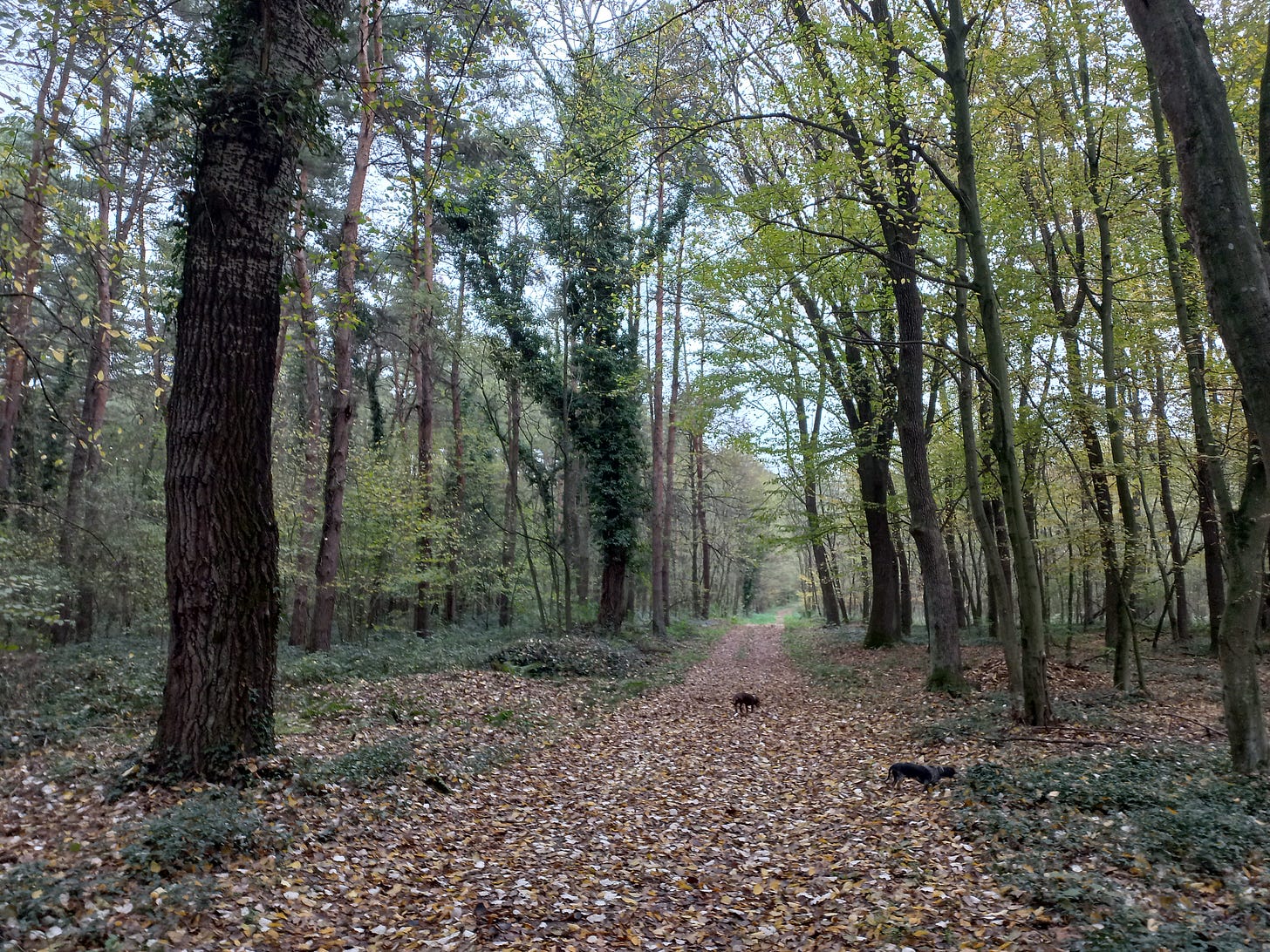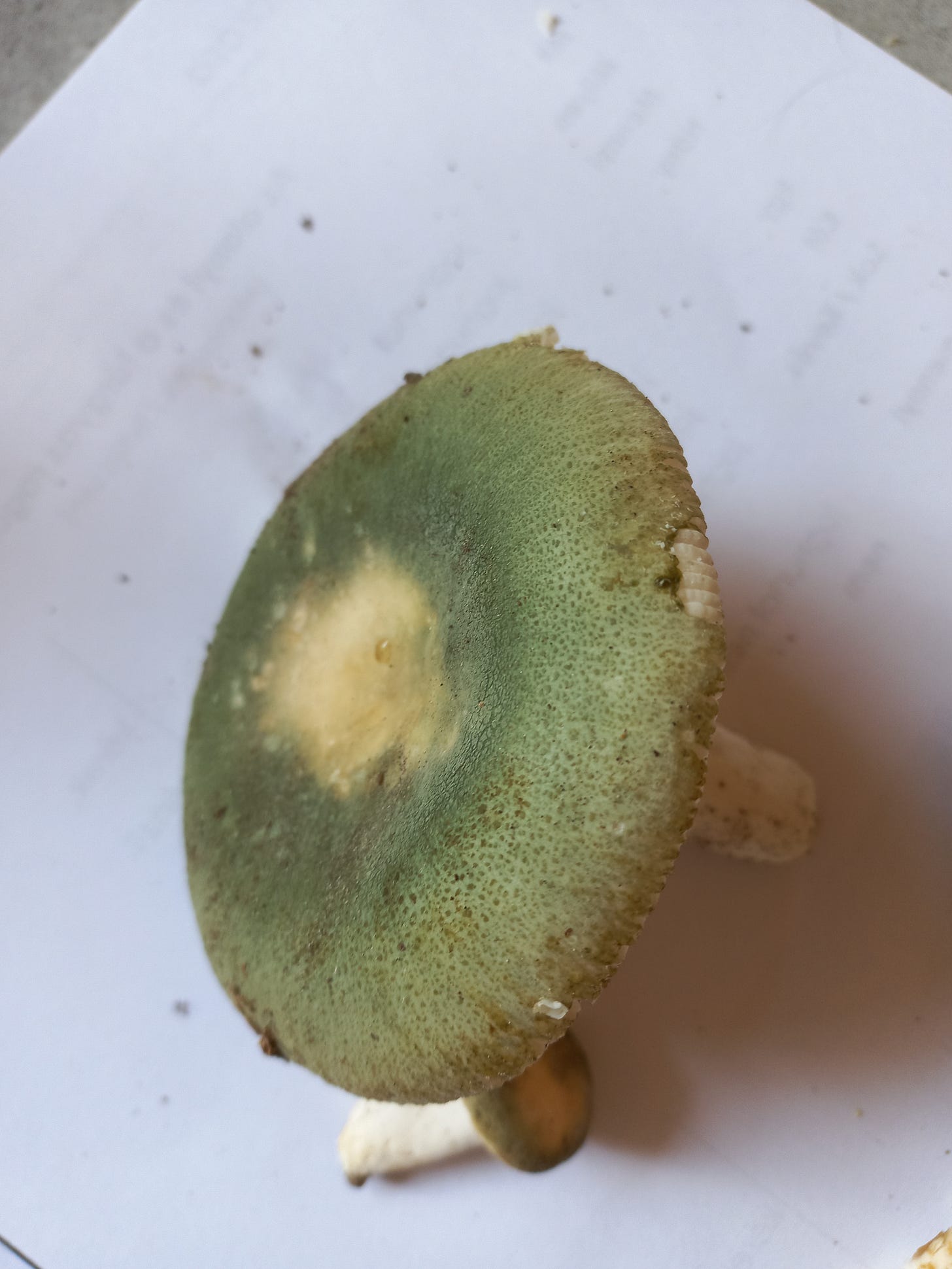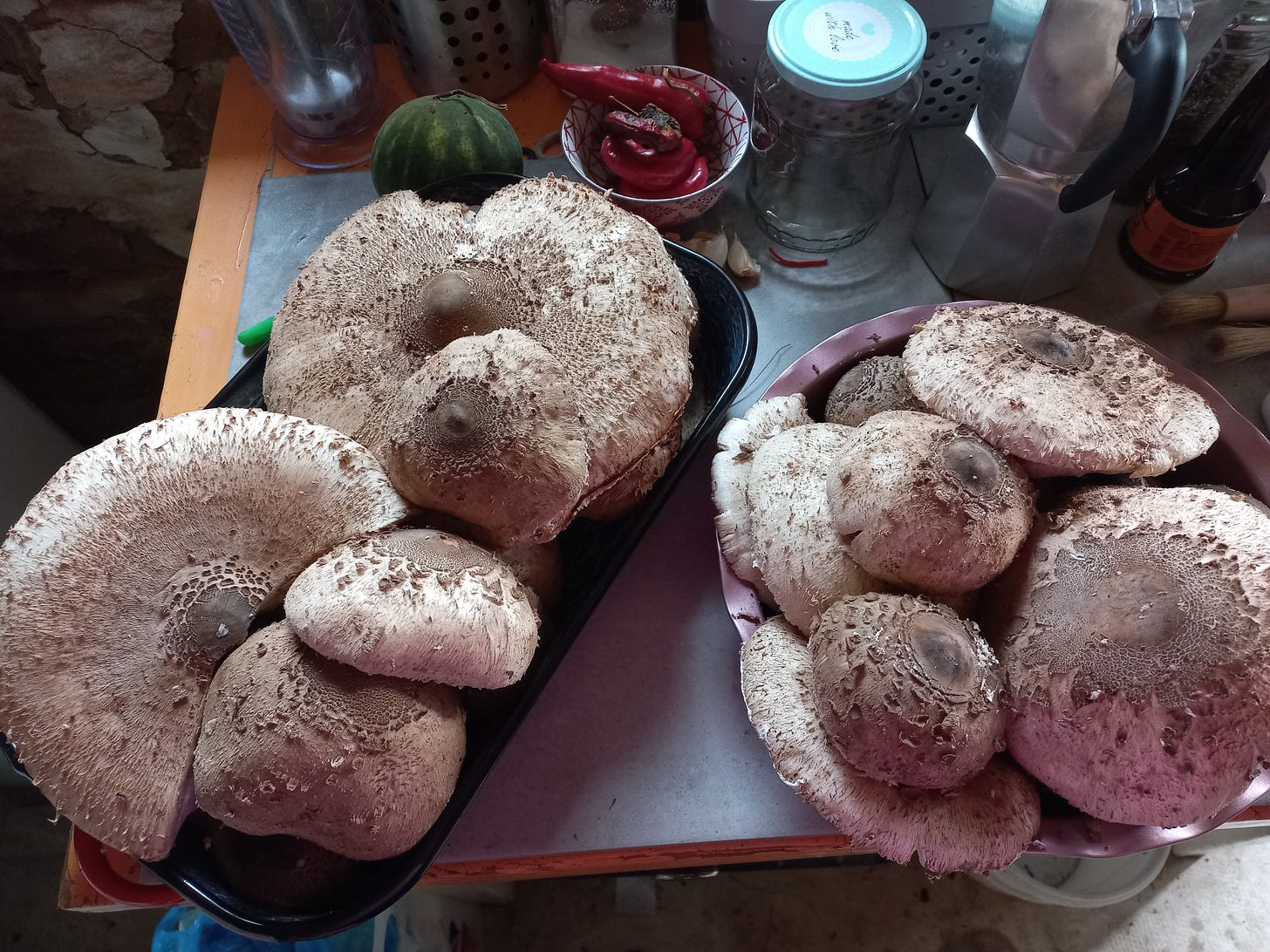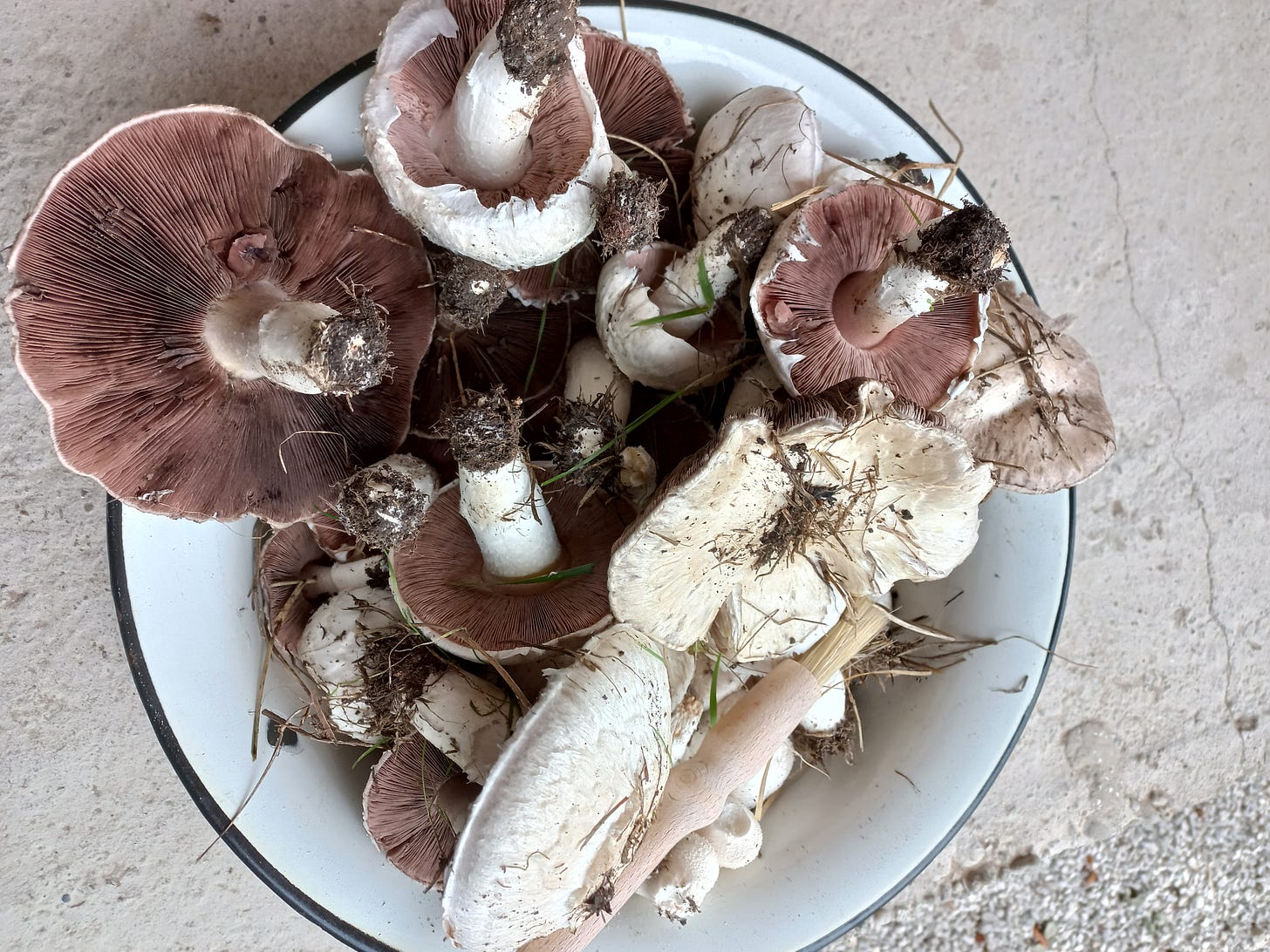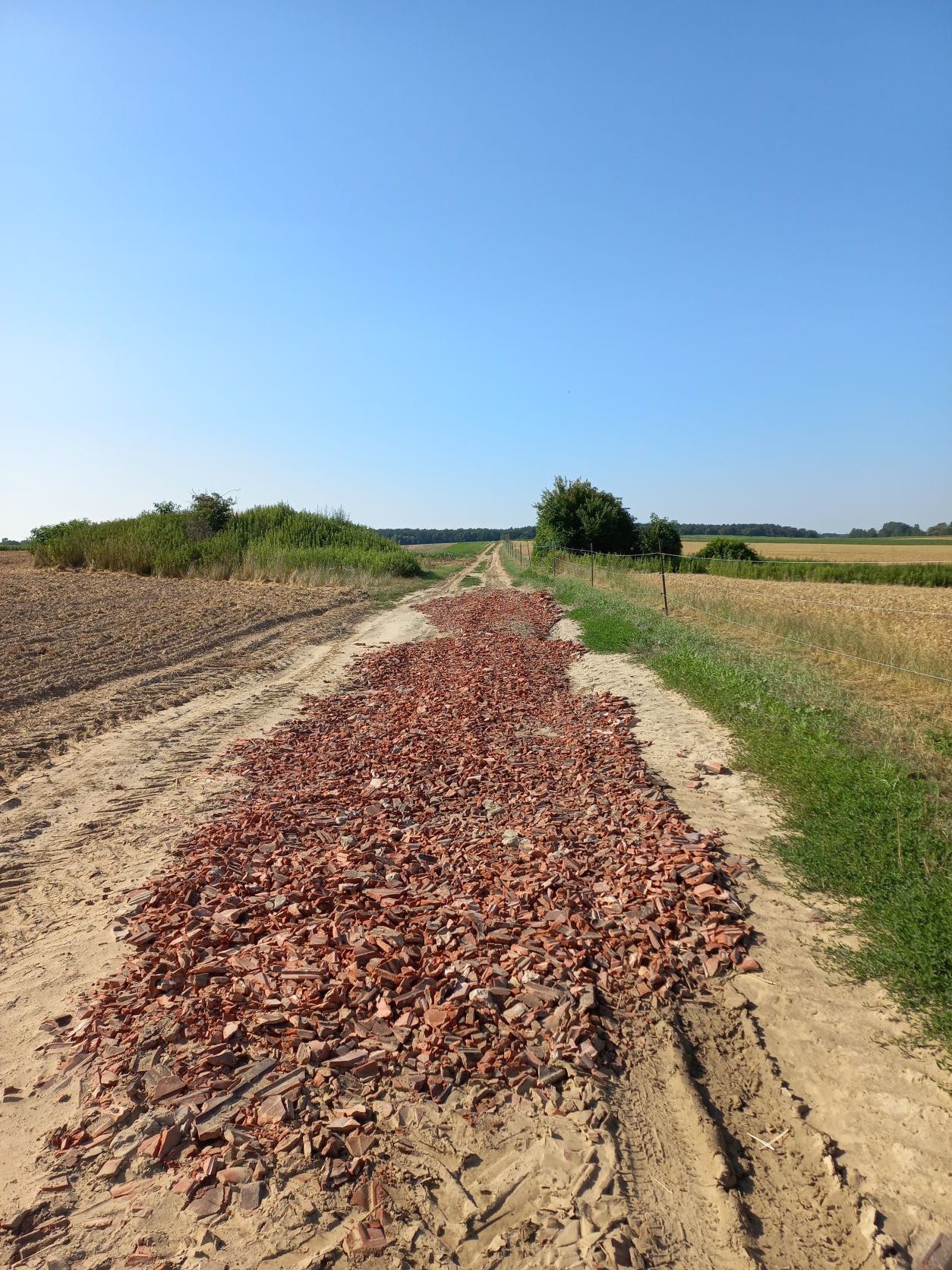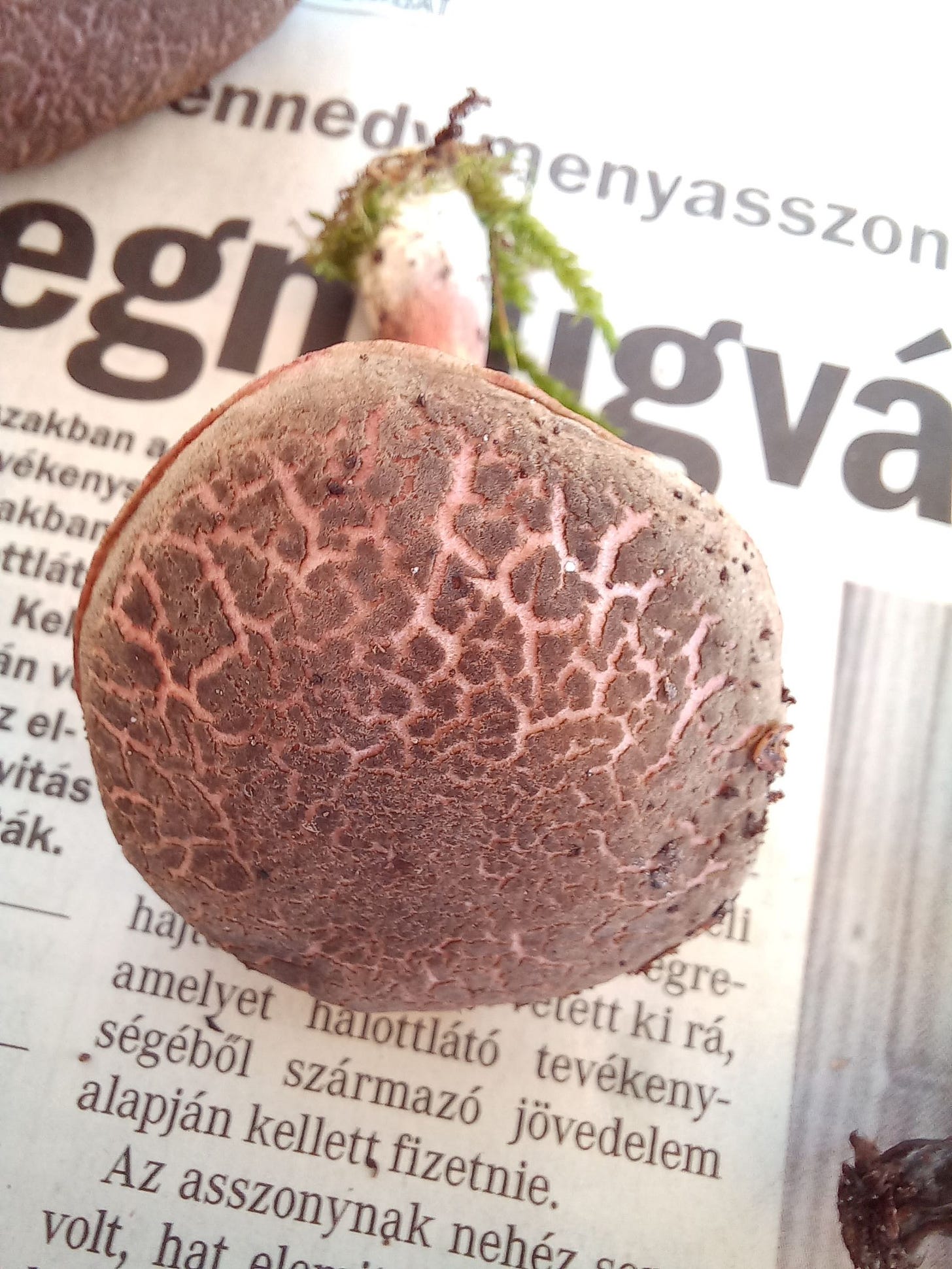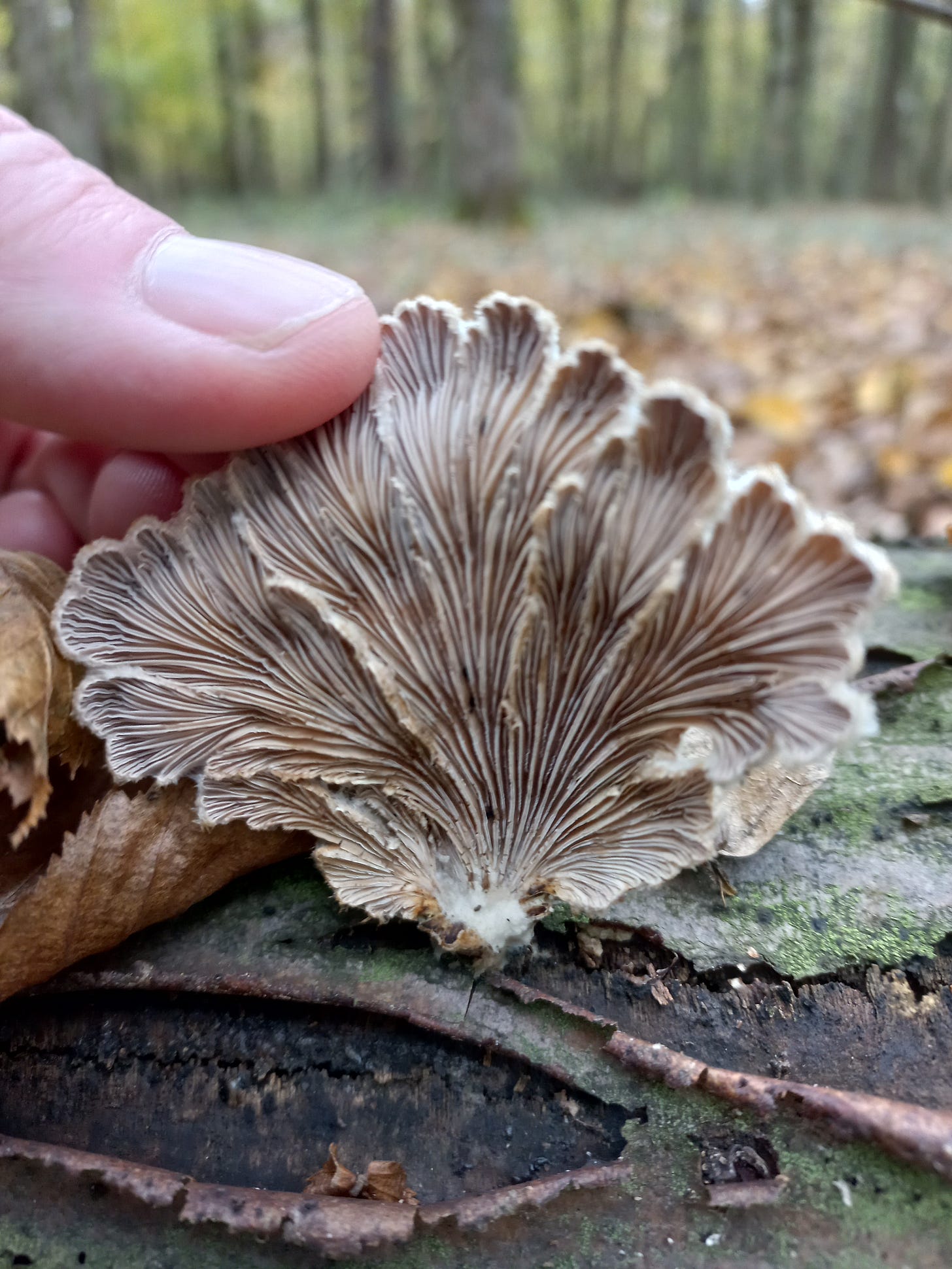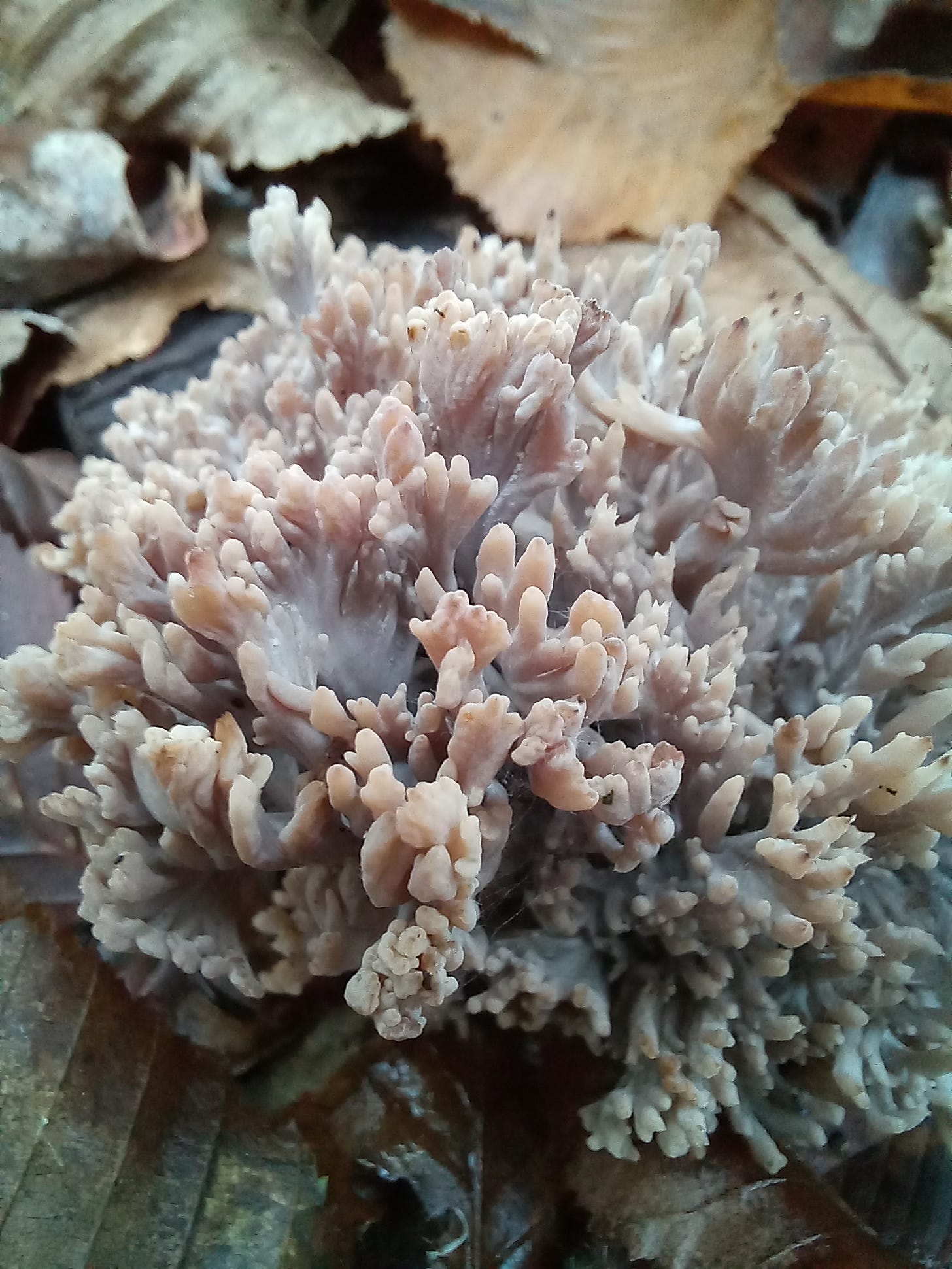We are in the season when things lightly tumble, full of grace, to the ground. The forest road is carpeted in oak and beech leaves, a patina of golden hues. Off to the sides, among the trees, the leaves lie several layers deep, like snow, like memories.
They are pretty, but they do add a degree of frustration to the hunt.
Chanterelles (Cantharellus cibarius) are the exact same yellow as the fallen leaves of the beech trees they grow under. Green Russula (Russula virescens) masquerade as the light blue-green undersides of leaves, and Black Trumpets (Craterellus cornucopioides ) lurk timeless as the shadows between them.
I recently found a Death Cap (Amanita Phalloides), much to my glee and terror. Glee because I recognized it immediately and had the opportunity to hold it and examine it up close, and therefore learn its features in a way that isn’t possible from photos. Terror because I realized how easily, with its plain, unassuming looks, certain death could be mistaken for something else.
Looking for mushrooms is not too different from making a puzzle, that meditative state of looking for the right piece among a jumble of shapes and colors. It’s about recognizing patterns and hues, and spotting other oh-so-slight incongruities at the edge of your field of vision.
The heart leaps at something in the distance. But is it a leaf — or a mushroom? You must approach to find out. Squinting and squatting, too, is required. It’s tiring and exhilarating work.
The leaves love to pretend they’re mushrooms, and the mushrooms are so very good at pretending to be leaves. Except macrolepiota and amanita muscaria. They don’t pretend to be anything other than themselves. (I have not yet found an amanita muscaria)
“Stop looking!” Daughter told me just yesterday. “Close your eyes and walk toward the path.”
“But, but, but, I’m just browsing,” I said. “Perusing. I’m not looking.”
“But then you’ll find more and have to keep looking. Come on! I’m tired of the trumpets. I want to go look for boletes.”
Perhaps those of you who came here for the life-abroad posts are tired of my newfound love of mushroom hunting. For that, I apologize. At any rate, you’re in good company.
Just the same, we will for(a)ge ahead along this train of thought and see where it leads.
Csaba, our neighbour second house down at the end of the road, waves to me as I head off on the road to the forest, and again when I return. Today, like most days, he wears his weathered army green shirt jacket overtop a proper button-down-collared shirt and skillfully mended pants of the same military green as the jacket. His face wears the fields and the weather; his skin is sun-darkened and creased.
Csaba doesn’t like mushrooms. It’s not a question of store bought vs. foraged and, as far as I know, there’s no family history of tragic death caused by eating the wrong mushroom. He just doesn’t like their taste and texture. He prefers kolbász (dried sausage) and krumpli (potatoes), and that’s fine by me because the area where the back end of his yard stretches into the field bordering the back end of ours is often flush with field mushrooms (Agaricus campestris). I pick there regularly without remorse.
I grin and hold up my blue Aldi bag full of macrolepiota feeling elated, as if I’ve won the lottery — but better because a certain amount of skill and knowledge involved was involved in getting my haul.
Csaba raises his eyebrows, grimaces, shakes his head lightly and chuckles. Topi, the extra large German Shepherd ambles over, and I am in the homestretch. I can taste it.
I love eating mushrooms; they’re one of my favorite foods.
In the before-Hungary times, mushrooms came (for me) in four varieties:
White button mushrooms from the store. Brown ones, too, were available but often inexplicably more expensive, though they tasted no different.
Canned button mushrooms. These existed only to be added to chili con carne.
Fancy, expensive mushrooms for sale at high-end grocery stores and market stands. These dry husks never seemed worth the expense or the fuss — I’m not really a foodie.
Lawn mushrooms to be mowed over and kept out of the dog’s reach, just in case.
Thinking back, I can recall only a mushroom-free terrain, a land barren of mycelia and fruiting bodies, both safe and tasteless. (This was certainly not actually the case. There were mushrooms; I just never paid them much mind.)
My recollections testify only to a lack of observation — gap in my perception, a blind spot, an oversight — not an absence of fungi.
Occasionally, mushrooms popped up in our yard, landing somewhere on the spectrum of useless to dangerous, with tinges of annoying and mysterious. I could identify shaggy ink caps (Coprinus comatus), but that was it (and you would have been hard pressed to get me to consider eating them).
The park near mom’s house is home to a large fairy ring of small, unidentified perky-capped mushrooms. I remember she pointed it out years ago on our way to a garage sale. I’d never heard of such a thing, and it delighted me. Fairies in the park? Imagine that!
What I notice, what I look for, has changed. This is the crux of the matter.
I have never foraged for mushrooms anywhere but here, in Hungary, in the forest down the road.
But here, I have witnessed an incredible, beautiful diversity of life. Every time I am in the forest, I am awed by the display, by what has newly bloomed or decayed, by the forest’s ebb and flow. This richness was always present — here and in other places — but I had never noticed it because I did not know how to see.
Now, I can confidently identify several mushrooms, and I know where certain types are more likely to show up. I have given some of these places in “my” forest names (for example, mushroom corner aka brittlegill bend) but mostly I’ve noted the slight differences of each environment. The chanterelles like the slopes and the oaks. The black trumpets are usually near the smooth-barked trees in sections where there are also some pine trees. The russula are here and there and often on the edges of the water pits, and they are very quickly maggot-ridden. The Jack O’Lanterns (Omphalotus olearius) line the road and the walls of the water pits — fittingly, since they glow in the dark.
These days, I head off into the forest in much the same way I sit down with my laptop at 11 p.m. to write on the sly after everyone is in bed. It’s an hour that turns into three. It’s fretting as I leave the forest and the road home stretches out in front of me and I worry that perhaps it’s later than I think (yes, it is) and that Husband is worried (not usually) or that I’ll be late starting work (not so far). And then I’m sore and hot and too tired to hurry, and my bag is heavy (or not) and I’m thirsty and the last kilometer is interminable.
(Issues with grumpy hunters have receded to whence they came, thankfully, but those thoughts, too, flicker across my mind.)
Coming back from a forest walk is like crashing into bed exhausted at 1 a.m. with blurry vision and dry eyes knowing the morning will suck but thrilled with what I’ve accomplished. Blissed out, I guess, is the feeling. Elated.
And then the work starts. There are two large soup pots full — overflowing — with black trumpets waiting on the round table in the outside “summer” kitchen for me to deal with them. I’m hoping for a hot sunny day, but we’re already at the end of October and those are becoming rare to none. I’ve set my sights on a dehydrator. The bounty must be preserved.1
Speaking of things coming down, this our roof. Was our roof.
It has served to shore up the road, to provide traction to vehicles and other things yet to come. It is a reminder of those things that once protected us, and how they now, passively, matter-of-factly support us on our path forward.
This stretch of the road has gotten a fair bit worse since the photo above. The red clay tiles have disintegrated and been ground steadily into the sandy road.
Our canopy has come down, littering the ground. What might grow from under it?
What I’ve noticed is that what I look for has changed.
Yesterday. Today. Tomorrow.
Each moment, a new idea, a new goal. The terrain shifts. The leaves tumble and settle. The mycelia blooms, their fruiting bodies poking out from the detritus of the summer’s bounty, a delectable or deadly suggestion.
Where do we go from here?
Strong undercurrents shape us, determine where we end up. What settles, what rises up?
“Hyphae are the white thread-like filaments that are the main body of a fungus. (The mushrooms that appear on the forest floor, are merely the fruiting bodies of the fungus.) The hyphae draw nourishment from the litter. This enables the fungi to grow and spread, while breaking down the structure of the dead plant material.”2
In the mushroom groups I have joined on social media, there’s a concept of “pick shaming.” This is when someone comments on a post (whether the poster is seeking an ID or just happily sharing photos of the days foraging) to criticize the person for picking too much or unnecessarily or not picking the right way. Pick shaming is generally verboten, but that doesn’t mean it doesn’t happen.
I never imagined people would argue over the right way to take a mushroom out of the ground (or in which amount), but they do (and more often than you might believe).
If mushrooms are visible, the mycelia is happily doing its thing, producing fruiting bodies, much the way apple trees produce apples. If I pick one of them, I am validating their existence, helping to spread the seeds, not damaging the tree. And so it is with the blooms of fungi and mycelia that stretch their fine threads just below the surface — in some cases, over thousands of acres.
Mycorrhiza describes a symbiotic relationship that forms between fungi and the root system of a vascular plant, such as a tree. As in all symbioses, both fungus and host benefit from the relationship, though in different ways. The fungus colonizes its host’s root tissues, improving the host’s moisture and nutrient absorption capabilities. In exchange, the host plant provides the fungus carbohydrates produced through photosynthesis. 3
On the one hand, what you pay attention to grows. (I’m paraphrasing from business or pop psychology advice, but it seems to hold true for mushrooms and their spores.) On the other, you can’t possibly know what is thriving below the levels you can observe. Perhaps this is why truffles are so prized.
Life teems along without you — or regardless of you and your petty interests. You are irrelevant, nothing more than a bloom in time, a flash of colour amidst a palette of bright and nuanced hues.
You, too, are nothing more than a fruiting body, connected by nearly invisible threads to a network of hosts and larger systems you cannot comprehend. You too will mature, become maggot-ridden and decompose back into the earth.
You’re just a nudge, a bump, a small difference in the leaf litter, in the shadows and hues. Poke your cap out from the leaves, stretch the stipe of your being, spread your gills.
What do you see from under that litter, that canopy?
What did you bloom to be?
A wood blewit? A trooping funnel? A humble cracking bolete?
We all can do nothing more than bloom and leave.
(And I intend to make the best of it.)
Sadly, it wasn’t. I managed to clean and store a small amount, and then time escaped me and the whole lot became moldy. I scattered them in the bushes across the street in the off chance some spores might spread and take hold. I might also have stomped my feet and said a few swear words. Bounty wasted.
https://treesforlife.org.uk/into-the-forest/habitats-and-ecology/ecology/decomposition-and-decay/
https://www.treesatlanta.org/news/mushrooms-and-their-relationships-with-trees/
